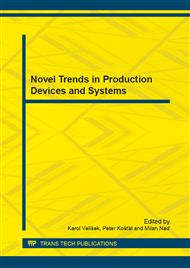[1]
L. Luca, S. Neagu-Ventzel, I. Marinescu, Effects of Working Parameters on Surface Finish in Ball-burnishing of Hardened Steels, Precis Eng 29 (2005) 253.
DOI: 10.1016/j.precisioneng.2004.02.002
Google Scholar
[2]
J. Kundrak, A.G. Mamalis, K. Gyani, V. Bana, Surface Layer Microhardness Changes with High-speed Turning of Hardened Steels, I. J. of Adv. Manuf. Techn, Vol.: 53, Issue: 1-4, (2011) 105-112.
DOI: 10.1007/s00170-010-2840-y
Google Scholar
[3]
Kundrak, J., Alternative Machining Procedures of Hardened Steels, Manufacturing Technology, Vol. 11, No. 11, Dec. (2011) 32-39.
DOI: 10.21062/ujep/x.2011/a/1213-2489/mt/11/1/32
Google Scholar
[4]
Sztankovics I, Kundrák J: Theoretical Value of Total Height of Profile in Rotational Turning, Applied Mechanics and Materials, Vol. 309, (2013) pp.154-161.
DOI: 10.4028/www.scientific.net/amm.309.154
Google Scholar
[5]
Beňo, J., Maňková, I., Vrabeľ, M., Kottfer, D., Roughness Measurement Methodology for Selection of Tool Inserts, Measurement, Vol. 46, Iss. 1, January (2013), 582–592.
DOI: 10.1016/j.measurement.2012.08.017
Google Scholar
[6]
Sovilj-Nikic I., Sovilj B., Kandeva M., Gajic V., Sovilj-NikicS., Legutko S., Kovac P., Tribological Characteristics of Hob Milling Tools from Economical Aspect, Journal of The Balkan Tribological Association, Vol. 18 nr. 4, (2012), pp.577-585.
DOI: 10.1051/matecconf/201928705003
Google Scholar
[7]
Byrne, G, Scholta, E, Environmentally clean machining processes - a strategic approach, CIRP Annals of Manufacturing Technology, Vol. 42 (1) (1993), p.471–474.
DOI: 10.1016/s0007-8506(07)62488-3
Google Scholar
[8]
Weinert K, Inasaki I, Sutherland JW, Wakabayashi T, Dry machining and minimum quantity lubrication, CIRP Annals of Manufacturing Technology, Vol. 53 (2) (2004): 511–537.
DOI: 10.1016/s0007-8506(07)60027-4
Google Scholar
[9]
E. Kuram, B. Ozcelik, E. Demirbas, Environmentally Friendly Machining: Vegetable Based Cutting Fluids, in: J.P. Davim (ed. ), Green Manufacturing Processes and Systems, Materials Forming, Machining and Tribology, © Springer-Verlag, Berlin, Heidelberg, 2013, pp.23-47.
DOI: 10.1007/978-3-642-33792-5_2
Google Scholar
[10]
Košťál, P., Mudriková, A., Laboratory of Flexible Manufacturing System, Advanced Materials Research, Vol. 429 (2012), 31-36.
DOI: 10.4028/www.scientific.net/amr.429.31
Google Scholar
[11]
Szalay, T., Czampa, M., Markos, S., Farkas, B., Investigation of Machinability of Iron Based Metal Matrix Composite (MMC) Powder Metallurgy Parts. Melville: American Institute of Physics, pp.300-303.
DOI: 10.1063/1.4751615
Google Scholar
[12]
El-Axir, M.H., Othman, O.M., Abodiena, A.M., Improvements in Out-of-roundness and Microhardness of Inner Surfaces by Internal Ball Burnishing Process, J Mat Proc. Tech. (2008) 196.
DOI: 10.1016/j.jmatprotec.2007.05.028
Google Scholar
[13]
ISO 25178 part 2 (2012) Geometrical product specification (GPS) - surface texture: areal - part 2: Terms, definitions and surface texture parameters. International Organization for Standardization.
DOI: 10.3403/30154352u
Google Scholar
[14]
Szabó, G., Kundrák, J.: Investigation of Residual Stresses in Case of Hard Turning of Case Hardened 16MnCr5 Steel, Key Engineering Materials, Volume 581, (2014) pp.: 501-504.
DOI: 10.4028/www.scientific.net/kem.581.501
Google Scholar


